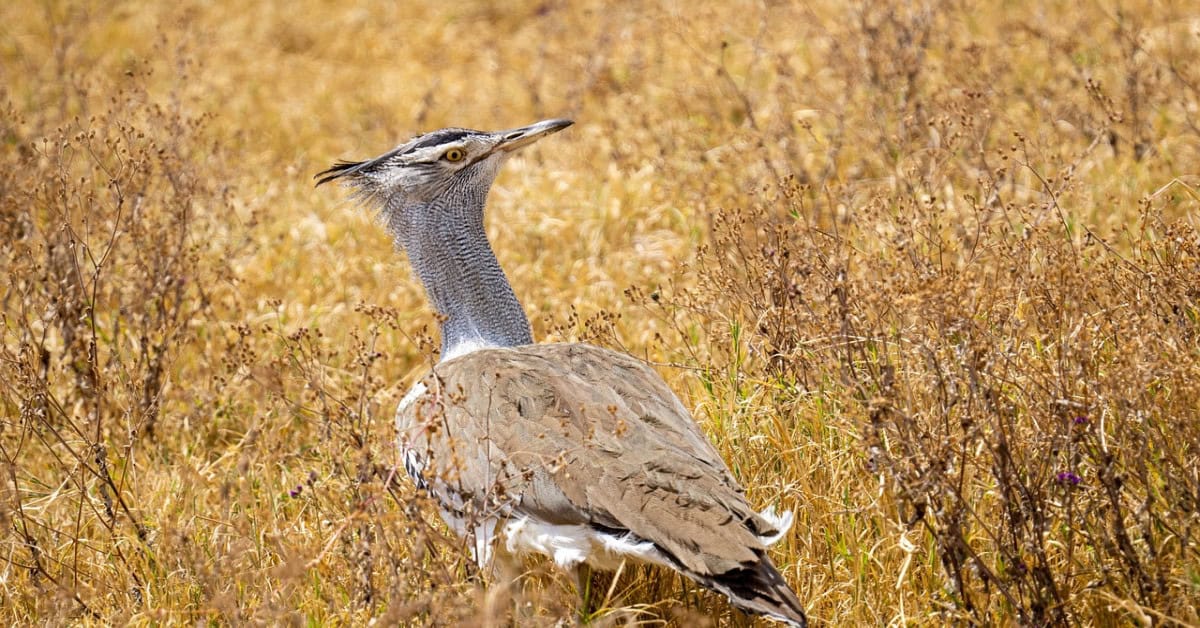The Great Indian Bustard Sanctuary is a vital refuge for one of the world’s most endangered birds. Located in Maharashtra, India, it plays a crucial role in preserving Great Indian Bustard Sanctuary biodiversity.
This sanctuary is not just a haven for the bustards but also home to various species of flora and fauna.
The sanctuary’s rich biodiversity helps maintain ecological balance and supports numerous life forms. Protecting this diversity is essential for the environment and future generations.
The significance of the Great Indian Bustard Sanctuary extends beyond conservation. It stands as a symbol of efforts to protect endangered species and their habitats. By understanding and preserving this sanctuary, we contribute to global biodiversity and environmental health.
Overview of the Great Indian Bustard Sanctuary
The Great Indian Bustard Sanctuary, established in 1979, aims to protect the critically endangered Great Indian Bustard. It was set up in Maharashtra, India, in response to the declining population of this majestic bird.
Over the years, the sanctuary has become a crucial area for conservation efforts, striving to provide a safe haven for the species and other wildlife.
Located in the Solapur and Ahmednagar districts, the sanctuary covers an area of about 8,496 square kilometers. The terrain is mostly dry grassland, interspersed with scrublands and agricultural fields.
This unique landscape provides an ideal habitat for the Great Indian Bustard and supports a diverse range of flora and fauna.
The mission of the Great Indian Bustard Sanctuary is to ensure the survival of the Great Indian Bustard and to promote biodiversity. The sanctuary’s goals include habitat preservation, species conservation, and environmental education.
By achieving these goals, the sanctuary aims to create a sustainable environment where wildlife can thrive.
Great Indian Bustard: An Endangered Bird Specie
Great Indian Bustard is one of the world’s most endangered birds, known for its impressive size and striking appearance. Males can reach up to one meter in height and weight around 15 kilograms.
They have a brown and white plumage with a distinctive black cap. These ground-dwelling birds are often found in arid and semi-arid grasslands, where they feed on seeds, insects, and small reptiles.
The conservation status of the Great Indian Bustard is dire. The species is listed as Critically Endangered by the IUCN. Their population has drastically declined due to habitat loss, hunting, and human interference.
Efforts are being made to protect their habitats and increase their numbers, but the road to recovery is long and challenging.
Several challenges threaten the survival of the Great Indian Bustard. Habitat destruction due to agriculture and development reduces their living spaces. Poaching and collisions with power lines are also significant threats.
Climate change adds another layer of difficulty, altering their habitats and food availability. Addressing these issues requires sustained conservation efforts and greater awareness.
Great Indian Bustard National Park
The Great Indian Bustard National Park, located in Rajasthan, is a critical area for conserving the Great Indian Bustard. Established in 1979, the park spans over 8496 square kilometers.
The park provides a protected habitat for the birds and supports various other wildlife species. The park’s dry grasslands and semi-arid regions create an ideal environment for the bustards.
There are both differences and similarities between the Great Indian Bustard Sanctuary and the Great Indian Bustard National Park. While the sanctuary is in Maharashtra and covers a larger area, the national park is in Rajasthan and focuses specifically on grassland habitats.
Both aim to protect the Great Indian Bustard and its ecosystem. However, the sanctuary also focuses on broader biodiversity conservation, reflected in the Great Indian Bustard Sanctuary Biodiversity.
Conservation efforts in the Great Indian Bustard National Park are robust and multifaceted. Initiatives include habitat restoration, anti-poaching measures, and community involvement in conservation activities.
The park also engages in research and monitoring programs to track the bustard population and health. These efforts are crucial in ensuring the long-term survival of the Great Indian Bustard and maintaining the ecological balance of the park.
Also Read: Exploring the Diversity of Amazon Forest Birds
Biodiversity in the Sanctuary
The Great Indian Bustard Sanctuary boasts rich biodiversity, crucial for a balanced ecosystem. It supports various species of plants, animals, and birds, making it a vibrant habitat.
This biodiversity is essential for the ecological health of the region, providing food and shelter for many species and maintaining the natural balance.
Key species of flora in the sanctuary include grasses like Dichanthium, Cenchrus, and Aristida, which dominate the landscape. Among the fauna, the sanctuary is home to the Indian Fox, Blackbuck (Kala Hiran), and Indian Wolf.
These species coexist, creating a complex and interdependent ecosystem that highlights the sanctuary’s ecological richness.
Maintaining biodiversity in the sanctuary is vital for several reasons. It ensures the survival of endangered species like the Great Indian Bustard. Biodiversity also supports ecosystem services such as pollination and seed dispersal, which are essential for plant regeneration.
Protecting this diversity helps sustain the sanctuary’s ecological balance and resilience against environmental changes.

In which Park the Great Indian Bustard is Found?
The Great Indian Bustard can primarily be found in the Desert National Park in Rajasthan. This park, with its vast stretches of sand dunes and grasslands, provides an ideal habitat for the species.
In addition to Desert National Park, smaller populations are also present in other areas like the Great Indian Bustard Sanctuary in Maharashtra and Rollapadu Wildlife Sanctuary in Andhra Pradesh.
Compared to other national parks, Desert National Park is the most significant stronghold for the Great Indian Bustard. Other parks, like the Great Indian Bustard Sanctuary and Rollapadu, also support the species but have smaller populations.
These areas offer crucial but limited habitats, making Desert National Park central to conservation efforts.
There have been some success stories in protecting the Great Indian Bustard, such as increased monitoring and habitat restoration. However, ongoing challenges include habitat loss, poaching, and collisions with power lines.
Conservationists continue to work on innovative solutions, such as installing bird diverters on power lines and engaging local communities in protection efforts. Despite these challenges, dedicated efforts provide hope for the species’ future.
Significance of Great Bustard Sanctuary
The Great Indian Bustard Sanctuary is ecologically significant for several reasons:
- It preserves the habitat of the critically endangered Great Indian Bustard.
- It supports various species of flora and fauna, ensuring biodiversity.
- It maintains ecological balance in the region’s grassland ecosystem.
The sanctuary plays a vital role in local and global conservation efforts. Locally, it provides a protected area for the Great Indian Bustard and other species. Globally, it contributes to the preservation of endangered species and highlights the importance of habitat conservation.
The sanctuary’s success can inspire similar efforts worldwide, emphasizing the need for collaborative conservation.
Additionally, the sanctuary impacts local communities and ecotourism. It creates opportunities for sustainable tourism, which benefits the local economy. Ecotourism also raises awareness about conservation and the importance of protecting endangered species.
The Great Indian Bustard sanctuary biodiversity attracts tourists and researchers, fostering a deeper connection to nature and conservation efforts. This influx of visitors helps fund conservation projects and provides jobs for local residents, making the sanctuary a valuable asset for both environmental and economic sustainability.
Conservation Efforts and Future Prospects
Ongoing conservation programs for the Great Indian Bustard focus on habitat protection, breeding programs, and community involvement. Efforts include creating safe zones, restoring grasslands, and installing bird diverters on power lines.
Breeding centers aim to increase population numbers, while educational initiatives encourage local communities to participate in conservation activities.
Past conservation efforts have seen both successes and failures. Successful initiatives include habitat restoration projects that have improved living conditions for the bustards.
However, challenges such as habitat loss, poaching, and inadequate enforcement of protection laws have hindered progress. Learning from these experiences, conservationists are continually adapting strategies to better address these issues.
Future plans for conserving the Great Indian Bustard involve expanding protected areas, enhancing breeding programs, and increasing public awareness.
Support for these efforts can come through donations to conservation organizations, volunteering, and advocating for stronger wildlife protection policies. By supporting these initiatives, individuals can contribute to the long-term survival of this critically endangered species.
Conclusion
The Great Indian Bustard Sanctuary plays a vital role in preserving the critically endangered Great Indian Bustard and maintaining biodiversity. Its significance extends beyond local conservation, impacting global efforts to protect endangered species.
The sanctuary’s diverse ecosystem is essential for ecological balance and supports various flora and fauna.
Supporting conservation efforts is crucial for the survival of the Great Indian Bustard. Contributions can be made through donations, volunteering, and advocating for stronger wildlife protection policies. Active participation in these initiatives can help ensure the sanctuary’s ongoing success.
The future of the Great Indian Bustard and its habitat depends on sustained conservation efforts. Continued focus on habitat protection, breeding programs, and community involvement is essential. With collective effort, there is hope for the recovery and flourishing of this majestic bird and its ecosystem.






